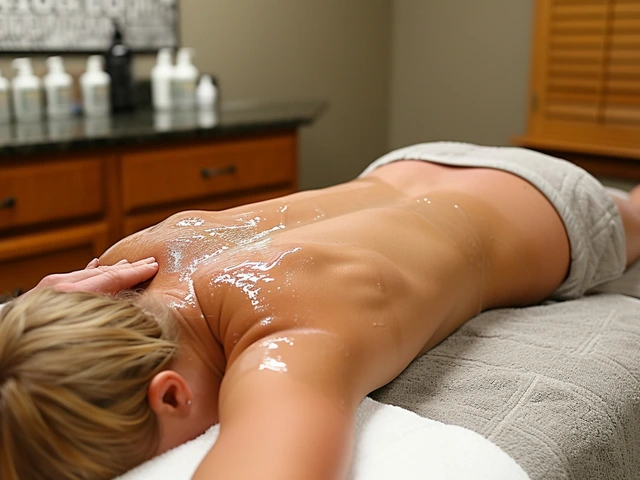Understanding Sports Massage: What's All the Hype?
Now, if you're like me, you might at first think massage is all about scented candles and whale sounds, but hold that thought. Sports massage isn't your average spa-day indulgence—it's a power tool in an athlete's kit. So, what's the big deal with sports massage anyway? Essentially, it's a specialized form of massage that caters specifically to the needs of athletes and active folks. Think of it as a pit stop for your body; where mechanics - in this case, massage therapists - address the wear and tear your muscles endure during training.
The concept isn't new; it's as ancient as those Greek Olympians, but the science and techniques have come a long way since then. A well-executed sports massage can enhance performance, speed up recovery, and reduce the risk of injury. How, you ask? By improving blood circulation to your muscles, breaking down knots and tension, and improving elasticity. That's a fancy way of saying you'll feel like your legs are made of springy spaghetti instead of hard, tired lasagna. And who wouldn't want that?
Kneading Out the Knots: The Benefits for Athletes
The perks of a good kneading session extend beyond just feeling awesome (which it does, by the way). As someone who routinely pushes her limits – and yeah, I'm not too humble to admit it – I can vouch that sports massage has done wonders for me. First off, it reduces muscle soreness after a grueling workout. I mean, we’ve all been there, walking downstairs sideways after leg day because it hurts less, right?
Secondly, it helps with flexibility and range of motion. So, if you’re trying to contort yourself into a human pretzel or just reach a bit further in your yoga class, sports massage could be your secret weapon. Another great thing is injury prevention. It addresses those sneaky imbalances and tight spots that might be plotting your downfall as we speak. And, for those unfortunate times injuries do pop up, it aids in the healing process by breaking down scar tissue and promoting cell regeneration.
Tap Into Your Body's Potential: Pre-Event Massage
Before a big event or competition, have you ever felt like your nerves were trying to escape your body? I have, and Elliott definitely knows to steer clear of me during those times. Well, sports massage jumps in as the unexpected superhero here. Before an event, a shorter, more dynamic massage can prepare your muscles to perform at their peak. It's not about relaxation at this stage – think of it more as a pep talk for your muscles.
The strokes are generally quicker and more stimulating to wake up the nervous system and blood flow. Yes, it feels a bit intense, but in a "let's conquer the world" kind of way, not a "why am I doing this to myself" way. It's all about getting you to that starting line or onto the field in the best shape possible, so those personal bests are not just dreams but actual goals you're ready to smash.
Post-Event Massage: Silencing the Screams of Your Muscles
After crossing that finish line or playing the last whistle, your body is usually celebrating the end of exertion by singing in the key of pain. That's where post-event sports massage comes into play. It's gentler and geared toward helping your muscles kick back and recover. Long, slow strokes flush out the toxins that build up during intense exercise – lactic acid, I'm looking at you.
It's like shaking out all the complexity of a day's work. And while it might not be the best time to chit-chat with your massage therapist about that funny thing Stella, my Siamese cat, did the other day, it's definitely a time to breathe deep and let the healing begin. Remember, the sooner you start recovering, the sooner you can get back out there to train, compete, and chase whatever athletic adventures you've got planned.
Regular Maintenance for High-Performance Engines
Just like high-performance cars need regular checks, our muscles do too. Routine sports massages are like those essential oil changes for your car, but instead of oil, it's all about keeping your muscle fibers smooth and happy. These sessions focus on your specific needs - areas that are overused or underutilized and might be feeling a bit neglected. It's tailored care that pays attention to the quirks of your training regimen.
For me, sometimes, it’s about dealing with desk-job-itis – the stiff shoulders and neck from blogging and editing photos too long. Having regular massages keeps that at bay and makes sure I don't turn into a hunchback before I hit the age of 30. They help keep you in tip-top shape and, in my experience, can be the difference between reaching your full potential and just scraping by.
DIY Sports Massage: Can You Rub Your Own Lamp?
So, what happens when you can't see your massage therapist? Is all hope lost? Heck no! Doing your own sports massage, a.k.a. self-myofascial release, can be quite effective. Grab a foam roller, a massage ball, or even a tennis ball, and start rolling. It's like being the DJ on the mixing board of your own muscles, finding those tender spots and applying just enough pressure to coax them into relaxation.
I've had my histrionic moments where I'm on the living room floor, foam roller under me, Stella looking down in condescending wonder, and I'm trying not to cry. But, despite the initial discomfort, self-massage works wonders. It’s like giving yourself a high-five for all the hard work. But it’s important to learn the right techniques; otherwise, you risk turning that high-five into an awkward thumb war with your muscles.
Choosing Your Massage Therapist: Not all Hands Are Created Equal
Now, selecting a massage therapist is kind of like choosing a life partner – you want someone who listens, who understands your highs and lows, and doesn’t laugh when you comically wince in pain. A good sports massage therapist will have an understanding of anatomy, physiology and should have experience working with athletes. They need to know the difference between what hurts so good and what's just plain torture.
It took me a few tries to find the right one. There was this one time I swore I had a therapist who was actually a retired interrogator, given the amount of pain inflicted. But once you find “the one,” it’s a beautiful relationship. They'll tailor their approach to your needs, help you understand your body, and keep pushing you toward those goals with every session, minus any unnecessary pain.
Fueling for the Massage: What to Eat and Drink
Just like adding premium gas to a sports car, what you put in your body matters before a massage too. There's a science to it, so no, chugging a gallon of water right before isn’t the way to go – unless you fancy sprinting to the bathroom mid-massage. Hydration is key: start increasing your water intake 24 hours before. And, honestly, eating a Godzilla-sized meal beforehand isn't the best idea either. Light meals with good proteins, healthy fats, and some carbs will keep you fueled without feeling like a stuffed turkey.
And let's talk about snacks – because who doesn't love a good snack? Nuts, fruits, or a small yogurt can be great pre-massage options. They'll keep the hangry monster at bay and are easy on the stomach. Because nobody wants to be the person whose stomach performs its own concert during a silent massage session. And trust me, my stomach is just as vocal as I am. It's all about finding the balance, so you're not too hungry or too full, and your body has the right nutrients to make the most out of the massage.
Building a Recovery Plan: Massage as Part of the Bigger Picture
So, we know by now that sports massage is awesome, but it's not a standalone hero in the story of recovery. It's one piece of a larger puzzle. Think about integrating massage into a recovery plan that includes proper nutrition, hydration, sleep, and active recovery. It's kind of like building a dream team for your body, where everyone plays an important role in getting you back in the game, and massage is the all-star player.
Without proper sleep, for example, even the best massage might not be as effective – because when we sleep, that's when the real magic happens; that's when our bodies repair and regenerate. And while massage does wonders for muscle recovery, complementing it with light exercises, such as swimming or cycling, can help maintain a good blood flow and keep those muscles flexible. The key is to find what works best for you and be consistent about it. Consistency is the secret sauce to maintaining that well-oiled will-o'-the-wisp physique.
Wrap Up: Embracing a Holistic Approach to Athletic Wellness
To close, if you’re serious about your sport or just passionate about staying active, sports massage should definitely be on your radar. It’s not just a passing trend or a luxury; it’s a proven method for helping your body perform at its best and recover faster. The holistic approach to wellness is the way forward, and massage is an essential part of that approach.
So, whether you’re a seasoned athlete or just getting off the couch (and hey, we’ve all had those Netflix marathons), consider what sports massage can do for you. I'm a firm believer in it, and I like to sprinkle sessions in as treats – or as necessary tune-ups for my rebellious body. Embrace the knowledge, find a good therapist or learn self-massage techniques, and keep chasing those personal victories. Because at the end of the day, the most important relationship we have is with our own bodies, so let's take care of them the way they deserve.






